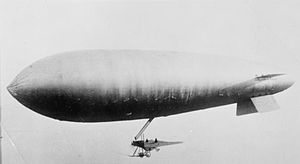SS class airship
| SS class | |
|---|---|
 |
|
| An SS class airship using a B.E.2c fuselage as a gondola | |
| Role | Patrol airship (submarine scout) |
| National origin | United Kingdom |
| Manufacturer |
Royal Aircraft Factory RNAS Kingsnorth RNAS Capel RNAS Wormwood Scrubs Vickers |
| First flight | 1915 |
| Introduction | 18 March 1915 |
| Primary user | Royal Navy |
| Number built | 60 original SS class (158 all variants) |
| Variants | SSP, SSZ and SST class |
SS (Submarine Scout or Sea Scout) class airships were simple, cheap and easily assembled small non-rigid airships or "blimps" that were developed as a matter of some urgency to counter the German U-boat threat to British shipping during World War I. The class proved to be versatile and effective, with a total of 158 being built in several versions.
Soon after the outbreak of World War I, the threat to British shipping from German submarines became increasingly apparent, with numerous losses occurring during October and November 1914. Then, on 4 February 1915, a communiqué issued by the Imperial German Admiralty declared that: "All the waters surrounding Great Britain and Ireland, are hereby declared to be a war zone. From February 18 onwards every enemy merchant vessel found within this war zone will be destroyed."
The situation had become critical and the Admiralty recognised that airships would be effective at spotting submarines and useful for Fleet observations, but at that time Britain's airship fleet consisted of just seven craft – four RNAS airships (HMA 17,18,19, and 20), two continental ships and a small Willows training craft – with only four airfields existing that possessed hangars capable of housing them. Consequently, on 28 February the First Sea Lord, Admiral Lord Fisher called a meeting with Commander E A D Masterman (Officer Commanding the Naval Airship Section) and representatives from Vickers and the London-based firm of Airships Limited to discuss the possibilities of creating a fleet of suitable patrol airships, sometimes referred to as "scouts".
The type was to have a speed of 40–50 mph (64–80 km/h), carry a crew of two, 160 lb (73 kg) of bombs, wireless equipment, fuel for eight hours flying, and capable of reaching an altitude of 5,000 ft (1,500 m). Most importantly the design had to be simple, in order to ease production and to facilitate training of the crews, since the new airships, designated the "Submarine Scout" or "Sea Scout" (SS) class, needed to be operational within weeks rather than months.
...
Wikipedia
